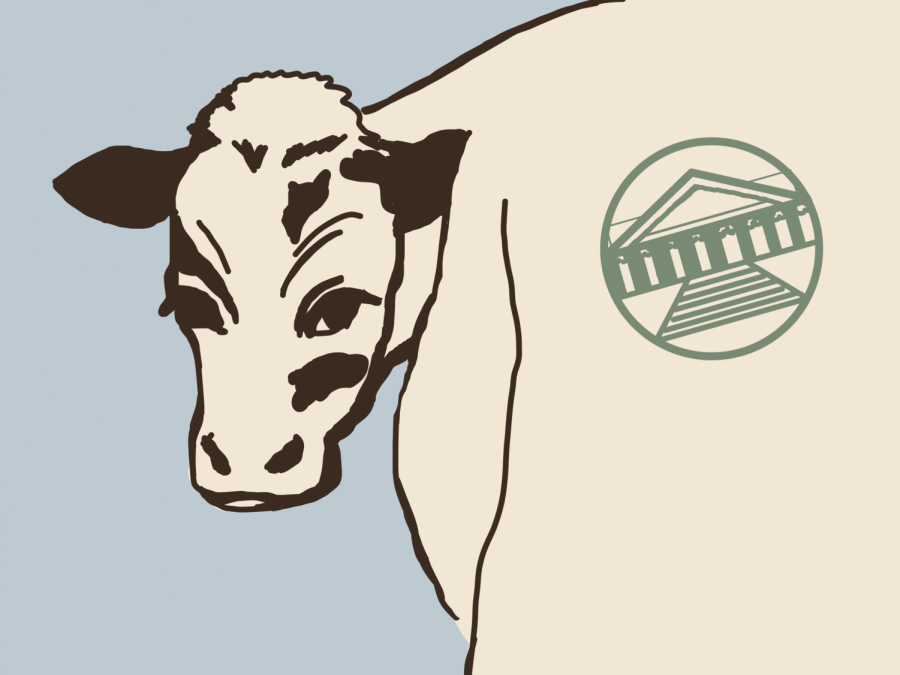The Dark Reality of Dairy
While dairy products are a staple to many of us, their production and consumption have several harmful consequences.
November 15, 2020
Growing up, my dad always told me to finish my milk if I wanted strong bones. In the line for hot lunch at school, my beverage choices were chocolate milk or regular milk packaged in a cute little carton with cartoon cows. And my cafeteria walls were filled with USDA dietary guideline posters that encouraged us to drink at least 3 cups of milk every day.
Our government claims dairy is a “great source” of protein, calcium, and potassium. But it turns out that there’s a catch (actually, multiple catches). So let’s break this down.
For starters, why is dairy consumption heavily encouraged by our government? That’s thanks to lobbying, where Big Dairy spends over five million dollars annually lobbying Congress to integrate dairy into our national nutrition policy. There are many, many problems with this.
The first problem is that children are urged to consume high amounts of dairy by government health organizations because of lobbying, even though dairy is actually unhealthy. Milk is loaded with sugar, saturated fat, and calories, and high dairy consumption directly correlates to our country’s high obesity rates. Some dairy products contain antibiotics and hormones that dairy cows are injected with, which can cause hormonal imbalances in humans and even lead to developing certain cancers. While our government officials’ pockets get fuller with Big Dairy money, the health of our nation is put at risk.
The second problem is that a number of Americans can’t even digest lactose, the sugar that makes up dairy. However, while lactose intolerance isn’t a problem in itself, dairy food stamps are. A majority of food stamp recipients are people of color, and “African American and Asian ethnicities see a 75% – 95% lactose intolerance rate,” according to Intermountain Healthcare. However, because our government subsidizes dairy products due to Big Dairy lobbying, food stamps cover the costs of almost every single dairy product, but not dairy alternatives. This forces low-income families who suffer from lactose intolerance to buy dairy products that can make them ill because they cannot afford the alternatives.
Then there’s the fact that the dairy industry is among the most abusive and exploitative toward animals. The image we have of a farmer sitting with a pail milking a cow is far from this industry’s reality. When female cows are two years old and are able to give birth, they are forcibly inseminated. They carry their calf for nine months, living in pens with concrete floors and hundreds of other dairy cows, sleeping in feces. Hours after delivery, the calf is taken from the mother; if it’s male, it’s sent to a meat farm, and if it’s female, it’s sent to another dairy farm. The mother produces just enough milk for her calf, but with the help of hormones pumped into her body, she unnaturally produces a surplus. She is connected to a machine with suction tubes on her udders and milked for weeks until her body stops producing. She is artificially inseminated again, and the process continues until she cannot breed. Useless to the dairy farmers, she is killed.
And if the animal abuse wasn’t enough, dairy farms are huge contributors to climate change. According to Sentiment Media, “approximately 1,410,000,000 liters” (or 372.5 million gallons) of water are used every day just to hydrate the cows so they can produce milk, and an additional “150 gallons of water per day per cow” are used to clean the cows, according to the United States Department of Agriculture Natural Resource Conservation Services. And on top of that, according to the USDA, the waste from just 200 dairy cows produces “as much nitrogen as the sewage from a community of up to 10,000 people.” This is unarguably horrific; the negative effects of dairy consumption drastically outweigh any of its possible health benefits.
Although we have little reign over Big Dairy lobbying or food stamps, we have the individual power to move away from dairy products for the sake of our livestock, our health, and our environment. With the climate crisis worsening, it’s essential we make changes in our personal lives to reduce our environmental impact. Even small changes, such as using oat milk in cereal and coffee, buying oil-based butters, and eating gelato instead of ice cream, can make a big difference. And your body will thank you by being less bloated, by producing less acne, by having less indigestion, and by losing weight.
Will you take the next step to reduce dairy consumption?


